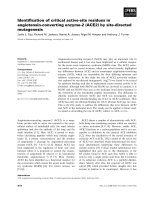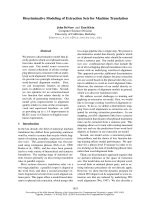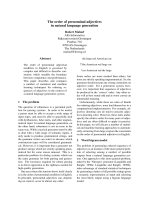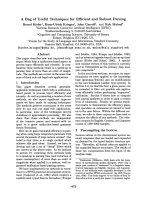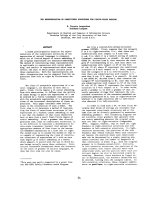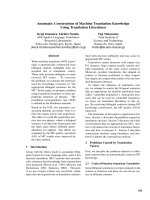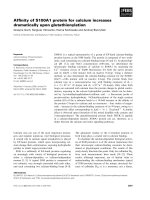Báo cáo khoa học: "Oxford Handbook of Critical Care for PDAs, 2nd edition" doc
Bạn đang xem bản rút gọn của tài liệu. Xem và tải ngay bản đầy đủ của tài liệu tại đây (69.25 KB, 1 trang )
Available online />The Oxford Handbook of Critical Care for PDAs provides
rapid access to crucial and synthetic information on most
aspects of management of critically ill patients.
What is gained from presentation in a personal digital
assistant (PDA)? Information is easily accessed at the
bedside, at any time of the day. However, users should not
expect to have all the information that is usually provided in
textbooks presented in this PDA version. Indeed, chapters
are succinct and concise; even if these present all the
essential information, details cannot be provided. The
information is easily accessible either directly from the index
and table of contents, or through easy links. These links are
well organized and are of course the essential gain from the
PDA format. Users can easily find their way through the
different chapters. Another important advantage of the PDA is
that the facility for making annotations is offered.
Most areas of intensive care medicine are covered, including
the classical pathophysiological disorders (shock and organ
failure), monitoring techniques, organ support technologies,
and intoxication management.
Organization and management of the intensive care unit is
also covered. This includes smoke and fire management.
Although at a first glance it might not seem useful to have fire
management dealt with on PDAs, one can imagine that this
might be helpful for the physician confronted with such a
stressful and difficult experience. Indeed, PDAs are always in
physicians’ pockets, and thus a rapid reminder of essential
information is easily available when one does not have the
time to search for information in an office. However, some
other parts of this chapter might seem less useful, such as
descriptions of audits or staffing. Scoring systems are also
briefly described; one might nevertheless regret that there is
no integrated automatic calculator.
The most interesting aspect of this guide is probably the use
of drug recommendations. For each pathology, therapeutic
options are discussed and, when applicable, drug dosages
are proposed.
Some chapters and assumptions are occasionally surprising.
The maximal dose for dopamine is set at 50 µg/kg per min,
whereas guidelines usually propose doses up to 25 to
30 µg/kg per min. In addition, the computed tomography
scanner is not proposed as a diagnostic tool for perforated
bowel, whereas the limitations of plain X-ray films and
ultrasounds are discussed.
Although space is not available to offer full referenced texts as
they are in textbooks, key papers are referenced in some
chapters to help readers to find additional information if needed.
Who should be interested in obtaining this PDA guide? It is
primarily dedicated to young doctors, nurses and paramedical
staff, who need essential information rapidly at the bedside.
However, this guide might also be interesting to more
experienced physicians, especially those looking for specific
information on less common diseases or uncommon intoxi-
cations. The guide offers first-line information; if additional
information is required it should be looked for in classical
textbooks.
Competing interests
The author declares that they have no competing interests.
Book report
Oxford Handbook of Critical Care for PDAs, 2nd edition
Daniel De Backer
Department of Intensive Care, Erasme University Hospital, Free University of Brussels, Route de Lennik 808,
B-1070 Brussels, Belgium
Corresponding author: Daniel De Backer,
Published: 1 February 2007
Critical Care 2007, 11:303 (doi:10.1186/cc5152)
This article is online at />© 2007 BioMed Central Ltd
Singer M, Webb AR: Oxford Handbook of Critical Care for PDAs, 2nd edition.
Oxford: Oxford University Press; 2006. ISBN 0-19-920586-8
PDA, personal digital assistant.
Page 1 of 1
(page number not for citation purposes)
